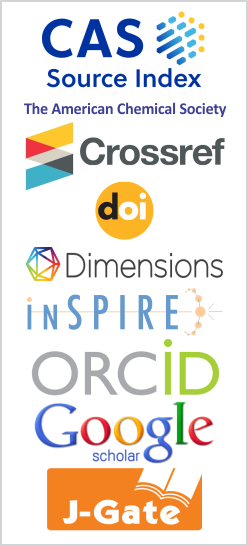Energy Levels and Oscillator Strengths of Ca V
DOI:
https://doi.org/10.26713/jamcnp.v8i1.1482Keywords:
Atomic structure, Excitation energies, Oscillator strengthsAbstract
We report an extensive and elaborate theoretical study of excitation energies and radiative data for the lowest 148 fine-structure levels of Sulphur-like Ca using Configuration Interaction Method (CIV3). We have included the relativistic effects using Breit-Pauli approximation by adding mass-correction, Darwin and Spin-Orbit terms to the non-relativistic Hamiltonian. Dipole allowed transitions are fined tuned by adjusting diagonal elements of the Hamiltonian Matrix. The exact identification of many levels becomes tedious due to the strong mixing between several fine-structure levels. We have compared our calculated values of energy with the data compiled by National Institute of standard and Technology (NIST) and found good agreement. We have reported data for many new levels which are not in the NIST database.
Downloads
References
M. Bergemann, Ionization balance of Ti in the photospheres of the Sun and four late-type stars, Monthly Notices of Royal Astronomical Society 413 (2011), 2184 – 2198, DOI: 10.1111/j.1365-2966.2011.18295.x.
E. Biemont and J. E. Hansen, Forbidden transitions in 3p4 and 4p4 configurations, Physica Scripta 34 (1986), 116, DOI: 10.1088/0031-8949/39/3/005.
H. S. Chou, J. Y. Chang, Y. H. Chang and K. N. Huang, Atomic Data and Nuclear Data Tables 62 (1996), 77 – 145, DOI: 10.1006/adnd.1996.0003.
J. H. T. Clemenston, P. Beiersdorfer and R. D. Wood, Spectroscopy of multiply charged titanium ions in high-density magnetic fusion plasmas, in: 14th International Conference on the Physics of Highly Charged Ions (HCI 2008) 1–5 September 2008, Chofu, Tokyo, Japan, Journal of Physics: Conference Series 163 (2009), 012018, DOI: 10.1088/1742-6596/163/1/012018.
E. Clementi and C. Roetti, Roothaan-Hartree-Fock atomic wavefunctions: Basis functions and their coefficients for ground and certain excited states of neutral and ionized atoms, Z · 54, Atomic Data and Nuclear Data Tables 14 (1974), 177 – 478, DOI: 10.1016/S0092-640X(74)80016-1.
R. D. Cowan, The Theory of Atomic Structure and Spectra, University of California Press, Berkeley (1981), URL: https://www.ucpress.edu/book/9780520038219/the-theory-of-atomic-structure-and-spectra.
G. Del Zanna, P. J. Storey and H. E. Mason, Atomic data from the IRON project, LXVIII. Electron impact excitation of Fe XI, Astronomy and Astrophysics 514 (A40) (2010), DOI: 10.1051/0004-6361/200913006.
R. Glass and A. Hibbert, Relativistic effects in many electron atoms, Computer Physics Communications 16 (1978), 19 – 34, DOI: 10.1016/0010-4655(78)90105-4.
A. Hibbert, CIV3 ” A general program to calculate configuration interaction wave functions and electric-dipole oscillator strengths, Computer Physics Communications 9 (1978), 141 – 172, DOI: 10.1016/0010-4655(75)90103-4.
E. B. Saloman and Y. K. Kim, Energy levels and transition probabilities in the ground-state configuration of sulfur-like ions, Atomic Data and Nuclear Data Tables 41 (1989), 339 – 356, DOI: 10.1016/0092-640X(89)90022-3.
E. B. Saloman and Y. K. Kim, Effects of configuration mixing in M1 and E2 transitions between ground-state terms of sulfurlike ions, Physical Reviews A 38 (1988), 577, DOI: 10.1103/PhysRevA.38.577.
J. Singh, S. Aggarwal, A. K. Singh and M. Mohan, Breit-Pauli atomic structure calculations for sulphur-like titantium, Canadian Journal of Physics 90 (2012), 833 – 847, DOI: 10.1139/P2012-074.
J. Sugar and C. Corliss, Atomic energy levels of the iron-period elements, potassium through nickel, Journal of Physical and Chemical Reference Data 14 (Supplement 2) (1985), 1 – 664, URL: https://www.nist.gov/document/jpcrds2vol14pdf.
L. A. Svenssion, The Transitions 3s23pk-3s3pkí…1 of Ti VI and Ti VII, Physica Scripta 4 (1971), 111, DOI: 10.1088/0031-8949/4/3/004.
Annual Report of National Institute for Fusion Science (2010-2011), Japan, URL: https://www.nifs.ac.jp/report/annrep11/index.html.
Downloads
Published
How to Cite
Issue
Section
License
Authors who publish with this journal agree to the following terms:- Authors retain copyright and grant the journal right of first publication with the work simultaneously licensed under a CCAL that allows others to share the work with an acknowledgement of the work's authorship and initial publication in this journal.
- Authors are able to enter into separate, additional contractual arrangements for the non-exclusive distribution of the journal's published version of the work (e.g., post it to an institutional repository or publish it in a book), with an acknowledgement of its initial publication in this journal.
- Authors are permitted and encouraged to post their work online (e.g., in institutional repositories or on their website) prior to and during the submission process, as it can lead to productive exchanges, as well as earlier and greater citation of published work.




